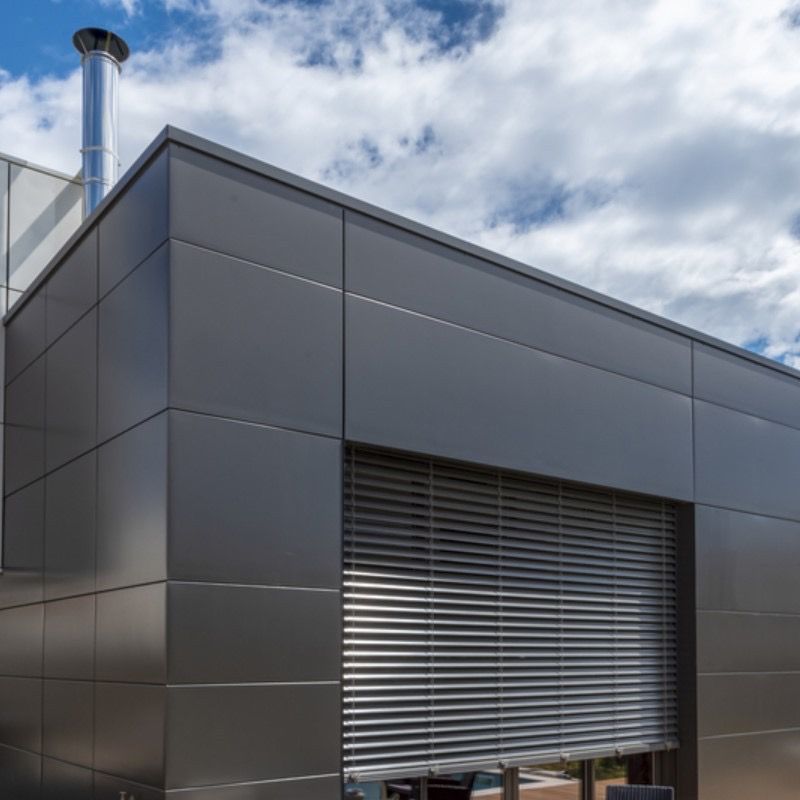Aluminum Composite Panels: A Durable and Versatile Building Material
2025-02-07
In the world of modern architecture and construction, materials that combine durability, aesthetic appeal, and versatility are highly sought after. Aluminum Composite Panels (ACP) have emerged as one of the leading materials in the industry. Known for their strength, lightweight nature, and sleek finish, these panels have become a popular choice for a variety of applications, from exterior facades to interior designs.
In this blog, we will explore what aluminum composite panels are, their benefits, applications, and why they are becoming a go-to solution for architects and builders.
What Are Aluminum Composite Panels?
An aluminum composite panel (ACP) consists of two thin layers of aluminum enclosing a non-aluminum core. This sandwich structure makes ACPs lightweight, yet highly durable and resistant to various environmental factors. The outer layers are often coated with a protective layer, which can be made of materials such as polyester, PVDF, or polyurethane, to provide additional durability and aesthetic options.
There are two main types of ACPs:
1. PE (Polyethylene) Core Panels – These panels have a polyethylene core and are typically used in interior applications or in areas that don’t require a high level of fire resistance.
2. FR (Fire-Resistant) Core Panels – These panels have a mineral-based core and are used in areas that require better fire resistance, making them ideal for exterior cladding and facades.
Benefits of Aluminum Composite Panels
1. Durability and Strength
- Weather Resistance: ACPs are resistant to a range of environmental conditions such as rain, wind, UV rays, and temperature fluctuations. This makes them an ideal material for building facades and exterior applications.
- Corrosion Resistance: Aluminum’s natural resistance to corrosion ensures that the panels retain their appearance and strength over time, even in harsh environments.
- Impact Resistance: Due to their composite structure, ACPs are highly durable and able to withstand impacts and physical wear and tear better than many other materials.
2. Lightweight
- The combination of aluminum layers and a non-aluminum core makes ACPs lightweight, reducing the overall weight of buildings without compromising structural integrity. This also makes them easier to handle, transport, and install.
3. Aesthetic Flexibility
- ACPs come in a wide variety of colors, finishes, and textures, including glossy, matte, metallic, and wood-like appearances. This aesthetic flexibility allows architects and designers to create visually striking facades and interiors that align with the modern design trends.
- The material can also be customized to mimic other materials like stone, wood, and concrete, giving a natural look without the added weight and cost.
4. Easy Maintenance
- The smooth surface of ACPs makes them easy to clean and maintain. Unlike materials such as wood or brick, which may require regular treatment to maintain their appearance, ACPs need only occasional cleaning to keep their glossy finish intact.
- The panels are also resistant to mold and mildew, making them ideal for locations with high moisture levels.
5. Sustainability
- Aluminum is a recyclable material, making ACPs an environmentally friendly choice. At the end of their lifecycle, ACPs can be recycled and repurposed, contributing to the reduction of waste and the conservation of resources.
Applications of Aluminum Composite Panels
Due to their wide range of benefits, aluminum composite panels are used in various industries, including construction, advertising, and interior design.
1. Exterior Cladding and Facades
- ACPs are widely used for exterior facades and building cladding due to their durability and ability to withstand outdoor conditions.
- The versatility in design allows for the creation of modern, sleek, and visually appealing buildings, often seen in shopping malls, office buildings, and high-rise apartments.
2. Signage and Advertising
- ACPs are often used in outdoor signage and billboards due to their ability to withstand UV rays and environmental elements.
- Their ability to be customized with various finishes makes them ideal for creating eye-catching advertising displays.
3. Interior Applications
- ACPs can also be used for interior wall cladding, especially in modern office spaces, retail stores, and exhibition halls.
- Their lightweight nature and variety of finishes make them ideal for creating stylish and functional interior features like partition walls, ceilings, and display boards.
4. Facade Renovation
- ACPs are an excellent option for renovating old buildings. They can be applied over existing facades, offering a quick, efficient, and aesthetically pleasing way to update the look of a structure without the need for extensive demolition or reconstruction.
5. Kitchens and Furniture
- The easy-to-clean nature and sleek finish of ACPs make them a popular material for kitchen counters, backsplashes, and furniture in both residential and commercial settings.
Why Choose Aluminum Composite Panels?
There are several reasons why architects, designers, and builders choose aluminum composite panels for both commercial and residential projects.
1. Cost-Effective
- While ACPs offer premium features, they are more cost-effective compared to materials like stainless steel, stone, or glass, making them a budget-friendly choice for projects that require high-quality finishes.
2. Versatility in Design
- Whether you're aiming for a contemporary urban look or a natural aesthetic, ACPs can be customized to fit the design vision of any project. They offer endless possibilities for creative expression while maintaining the durability required for building materials.
3. Enhanced Safety
- With fire-resistant options available, ACPs provide an added level of safety. Fire-resistant core panels are a common choice for facades in high-rise buildings and areas where fire codes are strict.
4. Long-Term Investment
- Due to their low maintenance and long-lasting durability, ACPs are a wise investment for both new constructions and renovation projects. They are an affordable choice that requires little upkeep over time, ensuring that the material remains functional and aesthetically pleasing for years.
Conclusion
Aluminum composite panels are a modern solution to the needs of contemporary architecture, offering a combination of durability, aesthetic flexibility, and sustainability. Whether you are involved in the construction of a high-rise building, the creation of a dynamic advertising display, or the renovation of an older building, ACPs provide a versatile and efficient solution for achieving the desired results.



